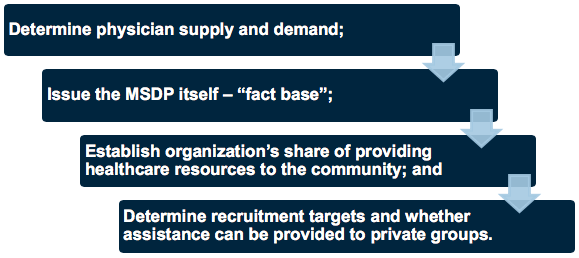
In our rapidly changing healthcare environment, adaptation of new integrated delivery models is essential for meeting patient care standards while concurrently running a successful operation. Add to that the recent requirements established in the Patient Protection and Affordable Care Act that call for qualifying healthcare organizations to conduct a Community Health Needs Assessment ("CHNA") every three years, and hospital-physician relationships have never been more important. A key strategy to strong physician relations is the knowledge of physician resource needs as they apply to the community served and the goals and strategy behind hospital-physician alignment.
With the passage of the Patient Protection and Affordable Care Act, a CHNA is no longer an elective process for hospitals that meet the requirements of a 501(c)(3) organization under the Internal Revenue Code. Such organizations are required to conduct a CHNA every three years and adopt an implementation strategy to meet the community health needs identified through such an assessment. Failure to do so could result in a hefty excise tax of $50,000. In addition to ensuring regulatory compliance under the Patient Protection and Affordable Care Act, a well-designed CHNA, to include a Medical Staff Development Plan ("MSDP"), will likely assist an organization with respect to its compliance obligations related to physician financial arrangements under both the IRS Code as well as Stark and the Anti-Kickback Statute.
A CHNA projects the local and/or regional needs for healthcare resources. The use of a MSDP, an enhancement many times included as part of a CHNA, will specifically provide strategic direction concerning the recruitment and retention of medical staff in accordance with community and hospital needs. A healthcare organization can utilize a MSDP to:
A well-designed medical staff development plan should include, at minimum, the following components:
The medical staff development planning process can be broken down into the following steps:

It is also important for healthcare organizations to have a defined policy regarding physician recruitment for their primary service area ("PSA") and secondary service area ("SSA"). A sample policy is illustrated below:

Gallagher offers a comprehensive approach to physician resource planning through our MSDP reports that combines qualitative and quantitative results and ensures accuracy and reasonableness. Our methodology is thorough and proven effective, but we are flexible and can easily customize our approach to better meet a client’s needs. After executing your recruitment plan, our experienced consultants can help your organization develop a compensation program that is not only market competitive, but also consistent with best practices for each unique role in the organization.
If you have any questions surrounding our firm’s MSDP service line, if you would like to receive a sample copy of our full MSDP report for your reference, or if you are interested in having our firm conduct a MSDP for your organization, do not hesitate to contact Kevin Loeffler at 612-337-1129.